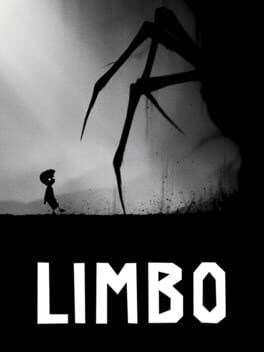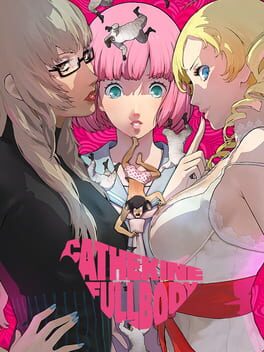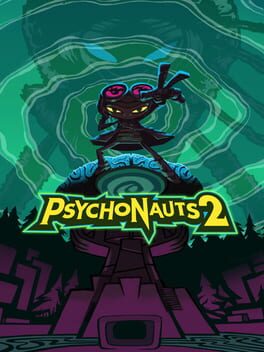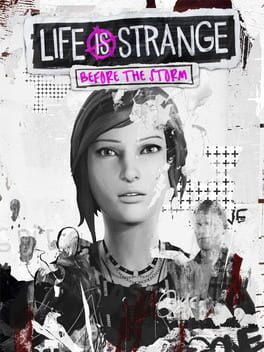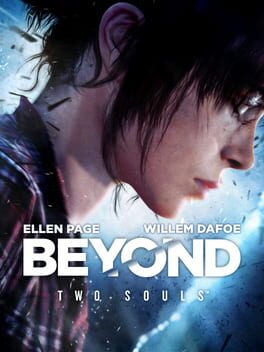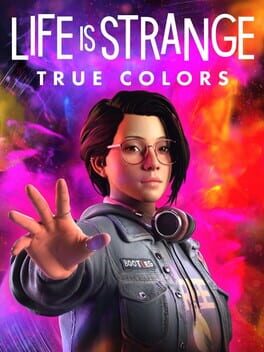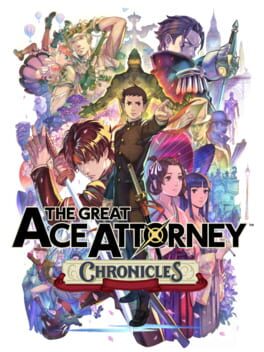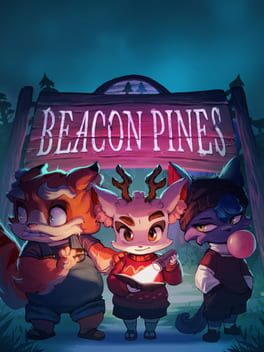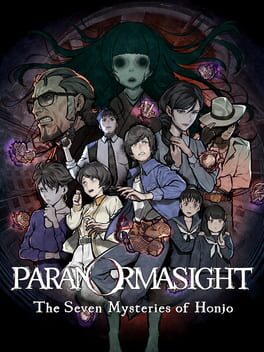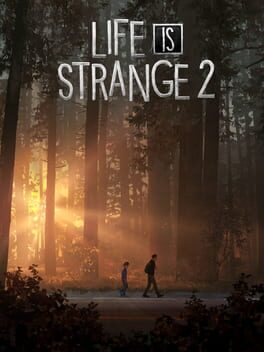adjansen
2010
The definition of style over substance, which doesn't matter so much at first when the world is so gorgeous and sinister and "wow" moments are frequent, but becomes obvious in the dull and drawn-out second half. Although I am not fond of "pretentious" as a descriptor this game truly earns the label with its "ambiguous" "symbolic" "narrative" that is basically the storytelling equivalent of an inkblot test.
2016
2017
2019
2017
Idk if it's coherent enough to be called its own subgenre, but atmospheric-horror-platformer-inspired-by-Limbo was definitely a thing in the 2010s. Little Nightmares is luckily better than Limbo thanks to its richer setting and story, and art design that draws on the grotesque caricatures of stop-motion animation and the more surreal works of Miyazaki to create a world approximating what I imagine a horror movie made by Studio Ghibli would feel like. So all of that is pretty rad. The game itself is...eh. Like Limbo, this is pretty much a cinematic experience dressed up as an interactive one. I mean, it is what it is, and works well enough as a game, but I guess I feel like the best and most essential parts of Little Nightmares could be condensed into an hour-long animated film, and you would not necessarily lose a great deal in translation. Or, to put it another way, this is an ideal Let's Play game—watching someone else play it is pretty darn close to the experience of playing it yourself.
2021
Okay possible hyperbole, but I think Raz might be one of the best video game character designs ever, up there with Mario, Pyramid Head, the King from Katamari, et al. He embodies so perfectly (apart from a lack of gender options which would have been nice, though I understand logistically why they were nigh impossible to provide) what every ten-year-old kid imagines they would look like as a cool spy. Like, oh hell yeah, I would wear some big-ass goggles on my head. I don't know why, I just would—and you bet your ass they would start glowing whenever I put them on. Oh and as a spy I would naturally rock a trenchcoat and gloves. And maybe, like, a turtleneck? Yeah, adults wear those. They seem classy. And one unruly lock of hair would always be escaping from my cool helmet, to show that I live on the wild side...
I fixate on this point because, if Psychonauts 2 illustrates anything, it is the power of good art design. The art team pretty much carries the game imo. Of course there are other elements at work here—gameplay, level design, writing, acting—and they certainly do their part, but I don't think any of it would have gripped me without the visual presentation. Maybe I am just a sucker for stylized graphics over realism, but I found this ineffably mid-2000s vaguely Dreamworks-adjacent eccentric animated film world so gosh-darn inviting. Given that I haven't even played the first game, I was surprised by how nostalgic this one made me feel.
So the throwback vibes are A+, while the rest is...a solid B? I have no major complaints—everything works insofar as I was compelled to keep playing until the end. But I was left feeling that, despite the nostalgia factor hitting me like a bull's eye, the substance of the story was aimed at someone younger. The characterization is, ironically, a little on the superficial side—although you ostensibly spend the game delving into the darkest corners of the psyche, I never felt like I got to scratch too far below the surface. The internal worlds, although visually dazzling and richly varied, are often quite simple thematically, reducing characters to a primary habit, illness, or fixation ("uh oh, this one's got anxiety!"). I am probably asking the game to be something it is not; if more time was spent developing complex character portraits, there would be less time for all the conventional game stuff—the hopping around and punching things and so on. But in my perfect world, there would have been fewer characters and fewer brains to explore in Psychonauts 2, with more unexpected depths revealed in each one.
I have to give a special shout-out to Raz's goofy family of circus acrobats, who are one of the most endearing families in video games. It's kind of wild that I can hardly think of any other games in which the main character has a big family. Usually you're some detached lone wolf with no connections, or your family is dead, or you have, like, a Pokémom who never leaves your house.
EDIT: Upon further reflection I'm docking another half-star because I really think the game bites off more than it can chew thematically and and there are inconsistencies in how things like consent are portrayed—like the game wants to say that tampering with minds, especially without permission, is bad and can't "fix" anyone, but then [redacted for spoilers] in the end?? Ultimately the game oversimplifies its subject matter a little too much to leave a good taste in my mouth, and I really do wish the characters were given more attention and development.
I fixate on this point because, if Psychonauts 2 illustrates anything, it is the power of good art design. The art team pretty much carries the game imo. Of course there are other elements at work here—gameplay, level design, writing, acting—and they certainly do their part, but I don't think any of it would have gripped me without the visual presentation. Maybe I am just a sucker for stylized graphics over realism, but I found this ineffably mid-2000s vaguely Dreamworks-adjacent eccentric animated film world so gosh-darn inviting. Given that I haven't even played the first game, I was surprised by how nostalgic this one made me feel.
So the throwback vibes are A+, while the rest is...a solid B? I have no major complaints—everything works insofar as I was compelled to keep playing until the end. But I was left feeling that, despite the nostalgia factor hitting me like a bull's eye, the substance of the story was aimed at someone younger. The characterization is, ironically, a little on the superficial side—although you ostensibly spend the game delving into the darkest corners of the psyche, I never felt like I got to scratch too far below the surface. The internal worlds, although visually dazzling and richly varied, are often quite simple thematically, reducing characters to a primary habit, illness, or fixation ("uh oh, this one's got anxiety!"). I am probably asking the game to be something it is not; if more time was spent developing complex character portraits, there would be less time for all the conventional game stuff—the hopping around and punching things and so on. But in my perfect world, there would have been fewer characters and fewer brains to explore in Psychonauts 2, with more unexpected depths revealed in each one.
I have to give a special shout-out to Raz's goofy family of circus acrobats, who are one of the most endearing families in video games. It's kind of wild that I can hardly think of any other games in which the main character has a big family. Usually you're some detached lone wolf with no connections, or your family is dead, or you have, like, a Pokémom who never leaves your house.
EDIT: Upon further reflection I'm docking another half-star because I really think the game bites off more than it can chew thematically and and there are inconsistencies in how things like consent are portrayed—like the game wants to say that tampering with minds, especially without permission, is bad and can't "fix" anyone, but then [redacted for spoilers] in the end?? Ultimately the game oversimplifies its subject matter a little too much to leave a good taste in my mouth, and I really do wish the characters were given more attention and development.
This review contains spoilers
LiS:BtS (no connection to the k-pop sensation) is a kinda fun teen delinquent/disaster lesbian simulator that suffers from excessive devotion to canon. Case in point: the ending. Ohhhh did the ending of this game piss me off. I mean, it strikes an effectively bittersweet note (thanks in part to "Bros" by Wolf Alice being a banger) but it would have been so easy to strike an even more thought-provoking one by just...letting you run away from Arcadia Bay with Rachel??
For a game series built on choose-your-own-adventure mechanics that was willing in the first game to play around with butterfly effect/monkey paw/multiple universe ideas, it seems especially egregious that you have no control over the outcome of this one. Think about it: If you run away with Rachel, she survives and you can live out your dreams together, but Chloe and Max never meet again and the events of the original game are erased from the universe. If you stay in Arcadia Bay, you are, in a way, sacrificing Rachel so that Chloe and Max can reunite and make the events of LiS possible. This would lend so much more gravity to the ending and really hammer home the wistfulness they clearly want you to feel.
I think if Deck Nine had felt more freedom to experiment, and less obligation to include cameos, this could have been a more interesting experience than what it is, which is basically Fanfiction I Would Feel Slightly Embarrassed to But Might Still Recommend to a Friend Who Was Into That Kind of Thing: The Game.
For a game series built on choose-your-own-adventure mechanics that was willing in the first game to play around with butterfly effect/monkey paw/multiple universe ideas, it seems especially egregious that you have no control over the outcome of this one. Think about it: If you run away with Rachel, she survives and you can live out your dreams together, but Chloe and Max never meet again and the events of the original game are erased from the universe. If you stay in Arcadia Bay, you are, in a way, sacrificing Rachel so that Chloe and Max can reunite and make the events of LiS possible. This would lend so much more gravity to the ending and really hammer home the wistfulness they clearly want you to feel.
I think if Deck Nine had felt more freedom to experiment, and less obligation to include cameos, this could have been a more interesting experience than what it is, which is basically Fanfiction I Would Feel Slightly Embarrassed to But Might Still Recommend to a Friend Who Was Into That Kind of Thing: The Game.
2013
A painful example of a game trying to imitate Hollywood movies in the least subtle most agonizingly self-serious manner imaginable. The only way to atone for this game's existence would be for Elliot Page to kick David Cage down a long flight of stairs (which I hope happens someday, let's be real that would be tight)
True Colors is much better than Deck Nine's previous effort, Before the Storm, probably because this one is a new story with original characters. If you are still playing the Life Is Strange games at this point you pretty much know the routine: the story will be tropey and melodramatic, with lots of angst and coming-of-age stuff, the setting will have kind of a "cozy Americana" vibe, there will be INDIE MUSIC and a dash of the supernatural. True Colors checks all the boxes, and even goes above and beyond in a few areas, like in a creative LARPing sequence.
What True Colors doesn't manage to capture from the first game (LiS 2 might, I haven't finished it yet) is that particular teenage sense that your problems are cosmic in significance, which is imo what makes the first game work despite being extremely silly. Even if you hate Max and Chloe, the game works really hard to convince you that their bond is somehow holding the universe in balance, which is how attachments you have at that age can feel.
True Colors is just as melodramatic—some very heavy shit happens, and the gameplay revolves around sensing other people's emotions, and at one point you can literally sing "Creep" to yourself alone in your room lmao—but never in a way that feels bigger than Alex herself or the cute little mountain town whose name I totally forgot. The stakes never feel larger than life, which, in a melodrama, a genre whose basic principle is "go big or go home," seems like a bad move. Let me feel GRIEF. Let me RAIL against the INDIFFERENT SKY. Let me FLIP OFF the clouds and SCREAM.
Also I swear to god there are so many white boys wearing flannel in this mfin town how on earth do you tell them all apart
What True Colors doesn't manage to capture from the first game (LiS 2 might, I haven't finished it yet) is that particular teenage sense that your problems are cosmic in significance, which is imo what makes the first game work despite being extremely silly. Even if you hate Max and Chloe, the game works really hard to convince you that their bond is somehow holding the universe in balance, which is how attachments you have at that age can feel.
True Colors is just as melodramatic—some very heavy shit happens, and the gameplay revolves around sensing other people's emotions, and at one point you can literally sing "Creep" to yourself alone in your room lmao—but never in a way that feels bigger than Alex herself or the cute little mountain town whose name I totally forgot. The stakes never feel larger than life, which, in a melodrama, a genre whose basic principle is "go big or go home," seems like a bad move. Let me feel GRIEF. Let me RAIL against the INDIFFERENT SKY. Let me FLIP OFF the clouds and SCREAM.
Also I swear to god there are so many white boys wearing flannel in this mfin town how on earth do you tell them all apart
2019
In defense of the Great Ace Attorney Chronicles, the presentation is fabulous. The steampunk character designs are snazzy, the animations are full of personality and life, the soundtrack is exhilarating, and there is plenty of the signature Ace Attorney goofball charm on display. As a cherry on top, one of the main characters is a broody gay Castlevania villain who alludes with suggestive frequency to his “hallowed chalice” and probably does nothing but listen to Wagnerian opera and file his nails in his free time. (Also, Susato and her little book <3)
Unfortunately it’s also possible to build a strong case against GAAC. Because I’m a killjoy, and because these games seem to get a free pass from most people, let’s look at some evidence. In this massive and lovingly rendered cast, there are, by my count, roughly forty named male characters, of every shape and size and age, two-thirds of whom are canonically older than thirty. (Of those over thirty, six play prominent recurring roles.) If you are beginning to suspect there might be fewer women in the game, congrats, you would be right! There are, in contrast, fifteen named women, four of whom are over thirty; of those four, only one is a semi-important character (the bad one, naturally).
Luckily, with such delightful character designs, I’m sure there will be plenty of variety in how the women look, right? Heck yeah—as a matter of fact there are two (2) female characters who are not conventionally attractive! (Both characters are simply fat—hardly the kind of inventive caricature we find in the male designs.) For further diversity, we have a Cute Judicial Assistant, Sexy Victorian Assassin, Cute Prima Ballerina, Cute Cockney Ragamuffin, Cute Girl Genius/Newspaper Serial Author, Cute Newlywed, Cute Yuri Bait, Sexy Witch, Sexy Housewife, Sexy Coroner, Spooky-Cute Goth Daughter, and uh Feisty-Cute Firecracker Salesgirl.
I know this might seem like outrageous nitpicking, and yes I know video game characters are designed to be appealing, and yes some of the men are hot. I’m not anti-hot-people. But in a game with so much care put into the art style, the disparity is bleak. If you can come up with forty different faces for dudes, you can probably come up with more than three faces for women. Jesus.
One could raise the old familiar argument: “Something historical blah blah but it was like that back then!” To which I would say: Holograms. Also this is a game in which a top-secret case highly sensitive to British national security is handled by a visiting student and a mysterious amnesiac. Absolutely nothing in GAAC makes any goddamn historical sense whatsoever. If the creators cared about history, color photography would not exist, and the queen would be aghast at all the foreigners running rampant in her courtroom.
Which brings me in a roundabout way to the story itself, which inhabits an awkward limbo between wacky cartoon and social commentary. Takumi seems to want to say something about racism, imperialism, the justice system, and government corruption, but he is significantly hampered by not understanding any of these things. Racism in the Takumi-verse is the result of a Japanese guy murdering your family. Corruption is the result of bad apples. Crime is the result of “letting the darkness consume you,” rather than, say, not having food. And so on. Worst of all, his critique of empire is one-directional. There is no attempt to draw any parallel between the British Empire and Imperial Japan. In fact, the narrative goes to some length to exonerate Japanese characters (except a tiny few) of wrongdoing; none of them have the racist misconceptions that the European characters are shown to have.
Lastly, holy moly, this game is looong, and I don’t think the fact that it was originally two games is much of an excuse. Way too much of GAAC—a solid 40% in my estimate—is artificial and unnecessary padding. You would not BELIEVE the mind-boggling number of gavel thwacks and podium pounds you will endure before end credits. It is at least four billion. The jury system is a pointless contrivance that only serves to draw out trials to agonizing lengths, and there is so much mind-numbing repetition of witness testimony and Herlock hijinks. Considering there is really just one big story being told here, there was no reason (except ¥¥¥) to release it as two games in the first place.
There is, however, a neat tap-dancing bit near the end that is almost worth the slog.
VERDICT: Guilty!! (of making me spend more than 60 hours on a game—using a guide no less, yikes)
Unfortunately it’s also possible to build a strong case against GAAC. Because I’m a killjoy, and because these games seem to get a free pass from most people, let’s look at some evidence. In this massive and lovingly rendered cast, there are, by my count, roughly forty named male characters, of every shape and size and age, two-thirds of whom are canonically older than thirty. (Of those over thirty, six play prominent recurring roles.) If you are beginning to suspect there might be fewer women in the game, congrats, you would be right! There are, in contrast, fifteen named women, four of whom are over thirty; of those four, only one is a semi-important character (the bad one, naturally).
Luckily, with such delightful character designs, I’m sure there will be plenty of variety in how the women look, right? Heck yeah—as a matter of fact there are two (2) female characters who are not conventionally attractive! (Both characters are simply fat—hardly the kind of inventive caricature we find in the male designs.) For further diversity, we have a Cute Judicial Assistant, Sexy Victorian Assassin, Cute Prima Ballerina, Cute Cockney Ragamuffin, Cute Girl Genius/Newspaper Serial Author, Cute Newlywed, Cute Yuri Bait, Sexy Witch, Sexy Housewife, Sexy Coroner, Spooky-Cute Goth Daughter, and uh Feisty-Cute Firecracker Salesgirl.
I know this might seem like outrageous nitpicking, and yes I know video game characters are designed to be appealing, and yes some of the men are hot. I’m not anti-hot-people. But in a game with so much care put into the art style, the disparity is bleak. If you can come up with forty different faces for dudes, you can probably come up with more than three faces for women. Jesus.
One could raise the old familiar argument: “Something historical blah blah but it was like that back then!” To which I would say: Holograms. Also this is a game in which a top-secret case highly sensitive to British national security is handled by a visiting student and a mysterious amnesiac. Absolutely nothing in GAAC makes any goddamn historical sense whatsoever. If the creators cared about history, color photography would not exist, and the queen would be aghast at all the foreigners running rampant in her courtroom.
Which brings me in a roundabout way to the story itself, which inhabits an awkward limbo between wacky cartoon and social commentary. Takumi seems to want to say something about racism, imperialism, the justice system, and government corruption, but he is significantly hampered by not understanding any of these things. Racism in the Takumi-verse is the result of a Japanese guy murdering your family. Corruption is the result of bad apples. Crime is the result of “letting the darkness consume you,” rather than, say, not having food. And so on. Worst of all, his critique of empire is one-directional. There is no attempt to draw any parallel between the British Empire and Imperial Japan. In fact, the narrative goes to some length to exonerate Japanese characters (except a tiny few) of wrongdoing; none of them have the racist misconceptions that the European characters are shown to have.
Lastly, holy moly, this game is looong, and I don’t think the fact that it was originally two games is much of an excuse. Way too much of GAAC—a solid 40% in my estimate—is artificial and unnecessary padding. You would not BELIEVE the mind-boggling number of gavel thwacks and podium pounds you will endure before end credits. It is at least four billion. The jury system is a pointless contrivance that only serves to draw out trials to agonizing lengths, and there is so much mind-numbing repetition of witness testimony and Herlock hijinks. Considering there is really just one big story being told here, there was no reason (except ¥¥¥) to release it as two games in the first place.
There is, however, a neat tap-dancing bit near the end that is almost worth the slog.
VERDICT: Guilty!! (of making me spend more than 60 hours on a game—using a guide no less, yikes)
2022
Welcome to the !&%#ed-up nonsense world of Utena, where the manga is worse than the anime, the movie slaps, the fandom is chill, and even the one random spin-off game for Sega Saturn is good?! wtf
*the manga being worse than the anime is kind of forgivable considering everything (in the known universe) is worse than the anime
*the manga being worse than the anime is kind of forgivable considering everything (in the known universe) is worse than the anime
This review contains spoilers
First of all, the presentation is wonderful, some of the best I have ever seen in a VN. (Although I don’t understand the apparently industry-wide allergy to using curly quotes and apostrophes.) On the basis of vibes, this is a five-star game. The soundtrack in particular is lovely.
Unfortunately a VN is not just an audiovisual experience, but first and foremost a story, and as a story, Paranormasight is...a lot. On one hand, I appreciate that, as visual novels go, this one is mercifully short, only 10-15 hours. On the other hand, there are so many heavy themes in this game that wind up underserved by the story, I...I can’t believe I’m saying this, but I...I think I wish it were longer?!
Well, some room to breathe might have helped, but the issues with the writing run quite a bit deeper, one of the main ones being that Ishiyama Takanari (credited both as director and sole writer) is unable to portray extreme emotions or psychological states. The characters work fine as archetypes—you got your gruff daddy cop, spunky schoolgirl, eccentric private eye, wealthy housewife, etc.—but their lack of human depth becomes obvious as soon as the emotional stakes are raised. As a result the darker and more lurid aspects of the story come off as cheap and often icky exploitation.
Paranormasight is not shy about including some of the most horrific shit that can happen to a human being: the lore contains a graphic parallel to the real-life torture and murder of Furuta Junka (in fact multiple children in the game are kidnapped, tortured, and murdered); and a girl violently coerced into participating in the murder of a child is later raped by a teacher threatening to expose her, and then summarily run over by a car. Bleak stuff! But rather than showing any genuine interest in how these horrors might affect somebody—like a grieving mother, or a teenager wracked with guilt after learning that her friend was suffering unimaginable abuse—the game seems more invested in unserious twists and gotcha moments. Like, hey, you know that girl you thought died by suicide because she was suffering unimaginable abuse? Turns out she was actually run over by a car!
(Half the plot hinging on a random hit-and-run is maybe the worst bit of writing in the game, but it is rivaled by the final mind-boggling twist of...aha, turns out you already killed the villain, because part of you knew she was the villain, but then a different part of you unkilled her, so you could learn that killing is bad before you kill her again, or something? Lmao. Nothing in the prologue makes any sense whatsoever retroactively—like how is Shogo, the blandest man in the world, or the spirit within him, or whatever, supposed to be this scion of good in the battle between good and evil when he/you immediately embark[s] on an unrepentant murder spree?)
The more low-key story beats, like Tetsuo’s absent-father angst, or the sinister corporate machinations of Hihaku Soaps, end up tragically overshadowed by Ishiyama’s insistence on explaining his dumb paranormal rules down to the smallest punctilio. Like, dude. I could not possibly give less of a shit about soul dregs! It is hard to care about the particularities of who is able to kill whom under what circumstances when these details so rarely matter. If the story played out as more of a pulpy death game, with the characters trying to outwit each other to survive, these details might feel more relevant (and the tone might feel more appropriate). But Paranormasight never quite finds its genre groove: it’s too predictable as a mystery, inconsistent as a thriller, and never fully commits to horror. In the end, it probably works best as the anime equivalent of a trashy ’80s buddy cop movie, or as a Monkey’s Paw-style morality play—although its ideas about morality are also pretty wonky. At one point it is suggested, with a straight face, that a kidnapping victim who kills her captor to escape might just as bad, deep down, as the guy who kidnaps her—a man who has tortured and murdered several people for kicks. Uh, what.
I almost kind of admire just how much this game bites off and tries to swallow without chewing. There’s a red herring suggesting police corruption will play a major role in the plot, while in the end it’s implied that people only hate the police because they are workaholics who don’t spend enough time with their kids (or because they’re just too darn good at catching the bad guys). There’s a subplot about juvenile gangs that raises the specter of all manner of social issues that are never addressed. There’s an unresolved tension with the story’s own attitude toward the supernatural; on one hand, it is very much real (and explained to death), but on the other, legends about the supernatural are falsely embellished memories of ordinary phenomena. There’s some meta stuff tossed into the blender, too, because why not. There’s the Storyteller’s gender being listed as “???” for some reason when he is only described using male pronouns (when gender-neutral pronouns are correctly used elsewhere in the script), an inconsistency I thought might be setting up for a twist, but no, it’s just weird. (I demand nonbinary Storyteller to be canon!!) There’s even more weird gender stuff when you consider that the original sin in this universe, unleashing unspeakable evil across generations, was a bad lady wanting to be pretty.
I would like to be charitable to this game because it is not without charm (and the music really does bang), but the story just feels so cynical and pointless. Paranormasight is a perfect illustration of what happens when a story is assembled from a list of popular tropes (or a “1980s Japan” wiki page) in order to check off boxes. It exists to elicit periodic “oooh, neat” reactions. Idk, maybe a game about horrifying child abuse should aim for something a little bit more?
Unfortunately a VN is not just an audiovisual experience, but first and foremost a story, and as a story, Paranormasight is...a lot. On one hand, I appreciate that, as visual novels go, this one is mercifully short, only 10-15 hours. On the other hand, there are so many heavy themes in this game that wind up underserved by the story, I...I can’t believe I’m saying this, but I...I think I wish it were longer?!
Well, some room to breathe might have helped, but the issues with the writing run quite a bit deeper, one of the main ones being that Ishiyama Takanari (credited both as director and sole writer) is unable to portray extreme emotions or psychological states. The characters work fine as archetypes—you got your gruff daddy cop, spunky schoolgirl, eccentric private eye, wealthy housewife, etc.—but their lack of human depth becomes obvious as soon as the emotional stakes are raised. As a result the darker and more lurid aspects of the story come off as cheap and often icky exploitation.
Paranormasight is not shy about including some of the most horrific shit that can happen to a human being: the lore contains a graphic parallel to the real-life torture and murder of Furuta Junka (in fact multiple children in the game are kidnapped, tortured, and murdered); and a girl violently coerced into participating in the murder of a child is later raped by a teacher threatening to expose her, and then summarily run over by a car. Bleak stuff! But rather than showing any genuine interest in how these horrors might affect somebody—like a grieving mother, or a teenager wracked with guilt after learning that her friend was suffering unimaginable abuse—the game seems more invested in unserious twists and gotcha moments. Like, hey, you know that girl you thought died by suicide because she was suffering unimaginable abuse? Turns out she was actually run over by a car!
(Half the plot hinging on a random hit-and-run is maybe the worst bit of writing in the game, but it is rivaled by the final mind-boggling twist of...aha, turns out you already killed the villain, because part of you knew she was the villain, but then a different part of you unkilled her, so you could learn that killing is bad before you kill her again, or something? Lmao. Nothing in the prologue makes any sense whatsoever retroactively—like how is Shogo, the blandest man in the world, or the spirit within him, or whatever, supposed to be this scion of good in the battle between good and evil when he/you immediately embark[s] on an unrepentant murder spree?)
The more low-key story beats, like Tetsuo’s absent-father angst, or the sinister corporate machinations of Hihaku Soaps, end up tragically overshadowed by Ishiyama’s insistence on explaining his dumb paranormal rules down to the smallest punctilio. Like, dude. I could not possibly give less of a shit about soul dregs! It is hard to care about the particularities of who is able to kill whom under what circumstances when these details so rarely matter. If the story played out as more of a pulpy death game, with the characters trying to outwit each other to survive, these details might feel more relevant (and the tone might feel more appropriate). But Paranormasight never quite finds its genre groove: it’s too predictable as a mystery, inconsistent as a thriller, and never fully commits to horror. In the end, it probably works best as the anime equivalent of a trashy ’80s buddy cop movie, or as a Monkey’s Paw-style morality play—although its ideas about morality are also pretty wonky. At one point it is suggested, with a straight face, that a kidnapping victim who kills her captor to escape might just as bad, deep down, as the guy who kidnaps her—a man who has tortured and murdered several people for kicks. Uh, what.
I almost kind of admire just how much this game bites off and tries to swallow without chewing. There’s a red herring suggesting police corruption will play a major role in the plot, while in the end it’s implied that people only hate the police because they are workaholics who don’t spend enough time with their kids (or because they’re just too darn good at catching the bad guys). There’s a subplot about juvenile gangs that raises the specter of all manner of social issues that are never addressed. There’s an unresolved tension with the story’s own attitude toward the supernatural; on one hand, it is very much real (and explained to death), but on the other, legends about the supernatural are falsely embellished memories of ordinary phenomena. There’s some meta stuff tossed into the blender, too, because why not. There’s the Storyteller’s gender being listed as “???” for some reason when he is only described using male pronouns (when gender-neutral pronouns are correctly used elsewhere in the script), an inconsistency I thought might be setting up for a twist, but no, it’s just weird. (I demand nonbinary Storyteller to be canon!!) There’s even more weird gender stuff when you consider that the original sin in this universe, unleashing unspeakable evil across generations, was a bad lady wanting to be pretty.
I would like to be charitable to this game because it is not without charm (and the music really does bang), but the story just feels so cynical and pointless. Paranormasight is a perfect illustration of what happens when a story is assembled from a list of popular tropes (or a “1980s Japan” wiki page) in order to check off boxes. It exists to elicit periodic “oooh, neat” reactions. Idk, maybe a game about horrifying child abuse should aim for something a little bit more?
2018
Life is Strange 2 is an odd one. On one hand, I admire the refusal to pander to fans of the first game, and willingness to try something new. Apart from a few easter eggs and cameos here and there, LiS2 truly could not care less about Max, Chloe, or Arcadia Bay, and I kind of like that energy. On the other hand, LiS2 doesn’t seem very aware of what made the first game compelling, and its attempt to tell a different kind of story ends up sabotaging a lot of what made the original work.
Life Is Strange was not by any metric a great work of art—it was a goofy, cringily written, emotionally manipulative teen melodrama—but it did have some effective hooks. There was a mystery to solve, a layered dynamic between the two leads, a quaint Twin Peaksy atmosphere with lots of archetypal characters, and there was the fun time-manipulation mechanic which let you see the immediate consequences of different narrative decisions before making up your mind.
Life Is Strange 2 lacks most of these, which would be okay, except it doesn’t do much to fill their absence. There’s little mystery this time beyond waiting to see if the brothers can make it to Mexico. The relationship between the brothers is sweet, but lacks the nuance of the Max/Chloe relationship, probably because one is still a kid, so the older one is pretty much just trying to be a good dad the whole time. The small-town vibes are jettisoned in favor of a road trip story with new locales in every chapter, which sounds fun in theory, but in practice ends up a slog, since every chapter opens with a bazillion descriptions to read and new characters to meet, who you already know will be gone soon, so there’s no real reason to care about them. Finally, the time-reversal mechanics are replaced with…the ability to tell your brother to fuck shit up with his brain, which is just not as interesting on a narrative level, since in every situation you basically have two options: tell your brother to fuck shit up, or tell him to not.
What LiS2 does retain from the original is its earnest sincerity and soap opera plot developments, two traits that serve the game less well than its predecessor. Life Is Strange was packed full of ludicrous teen drama, but it knew what kind of story it was telling, and never stepped too far outside the bounds of an edgy CW show. The themes of LiS2 are more overtly political, and as a result the game feels like a weird time capsule preserving a particular flavor of post-Obama mopey liberalism. The main messages seem to be: racism bad, border wall bad, america.....good? But the only way the writers know how to convey these simple ideas is by subjecting the protagonists to an unending parade of harassment and abuse. To be clear, there is nothing wrong with making a game with an anti-racist message, or with portraying racial violence, but the game simply ends up making the same points over and over, without deepening its themes or analysis. It feels awkward in the way that white liberals patting themselves on the back for recognizing racism often does.
I didn’t hate Life Is Strange 2. There are some touching moments along the way. But I really wish I could say its boldness pays off, when sadly the opposite is more often true. Also the soundtrack could have used a whole lot more Sufjan Stevens
Life Is Strange was not by any metric a great work of art—it was a goofy, cringily written, emotionally manipulative teen melodrama—but it did have some effective hooks. There was a mystery to solve, a layered dynamic between the two leads, a quaint Twin Peaksy atmosphere with lots of archetypal characters, and there was the fun time-manipulation mechanic which let you see the immediate consequences of different narrative decisions before making up your mind.
Life Is Strange 2 lacks most of these, which would be okay, except it doesn’t do much to fill their absence. There’s little mystery this time beyond waiting to see if the brothers can make it to Mexico. The relationship between the brothers is sweet, but lacks the nuance of the Max/Chloe relationship, probably because one is still a kid, so the older one is pretty much just trying to be a good dad the whole time. The small-town vibes are jettisoned in favor of a road trip story with new locales in every chapter, which sounds fun in theory, but in practice ends up a slog, since every chapter opens with a bazillion descriptions to read and new characters to meet, who you already know will be gone soon, so there’s no real reason to care about them. Finally, the time-reversal mechanics are replaced with…the ability to tell your brother to fuck shit up with his brain, which is just not as interesting on a narrative level, since in every situation you basically have two options: tell your brother to fuck shit up, or tell him to not.
What LiS2 does retain from the original is its earnest sincerity and soap opera plot developments, two traits that serve the game less well than its predecessor. Life Is Strange was packed full of ludicrous teen drama, but it knew what kind of story it was telling, and never stepped too far outside the bounds of an edgy CW show. The themes of LiS2 are more overtly political, and as a result the game feels like a weird time capsule preserving a particular flavor of post-Obama mopey liberalism. The main messages seem to be: racism bad, border wall bad, america.....good? But the only way the writers know how to convey these simple ideas is by subjecting the protagonists to an unending parade of harassment and abuse. To be clear, there is nothing wrong with making a game with an anti-racist message, or with portraying racial violence, but the game simply ends up making the same points over and over, without deepening its themes or analysis. It feels awkward in the way that white liberals patting themselves on the back for recognizing racism often does.
I didn’t hate Life Is Strange 2. There are some touching moments along the way. But I really wish I could say its boldness pays off, when sadly the opposite is more often true. Also the soundtrack could have used a whole lot more Sufjan Stevens
